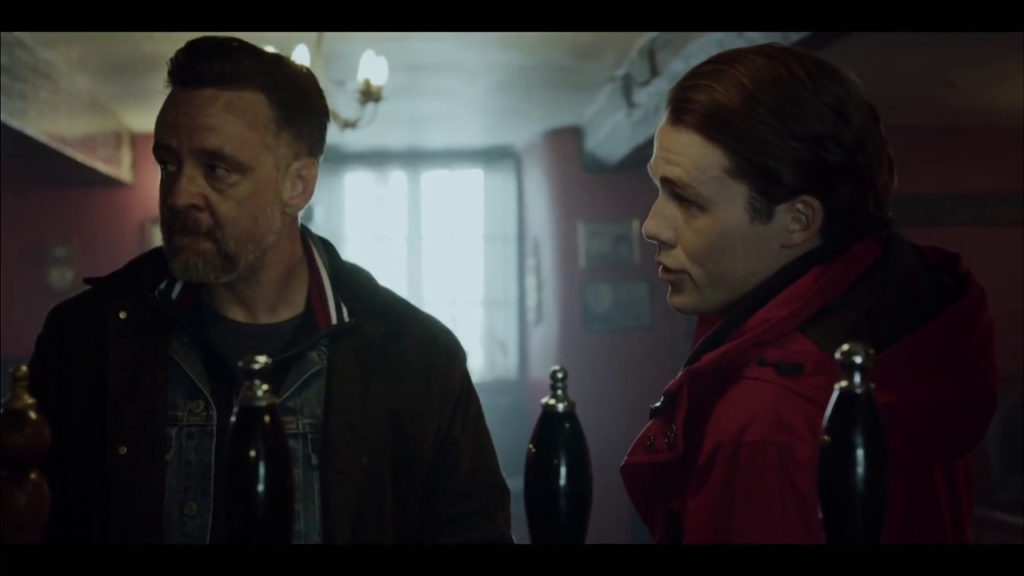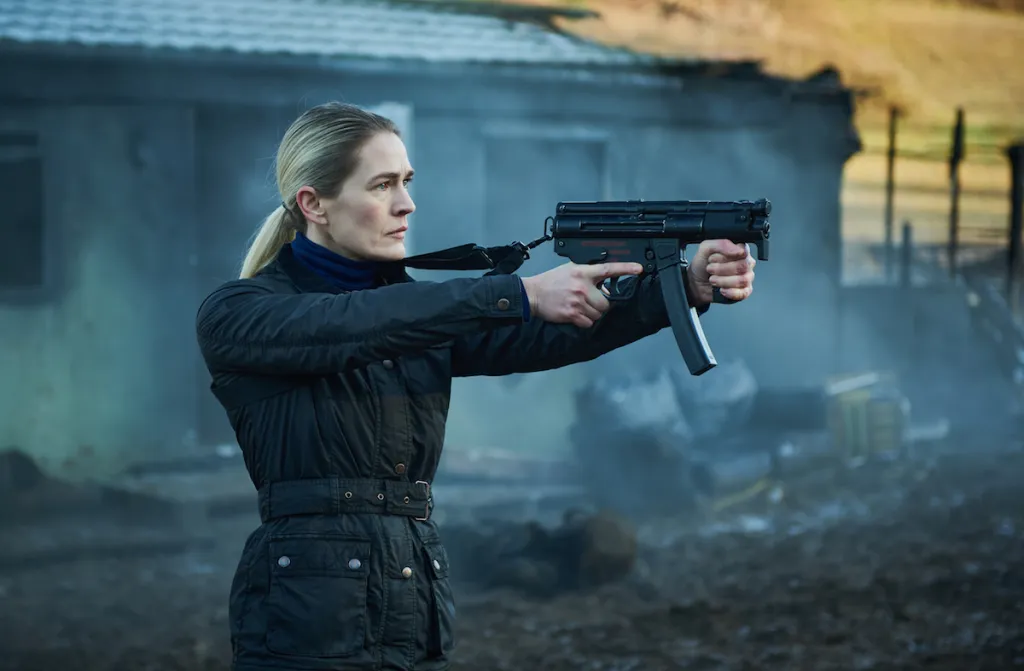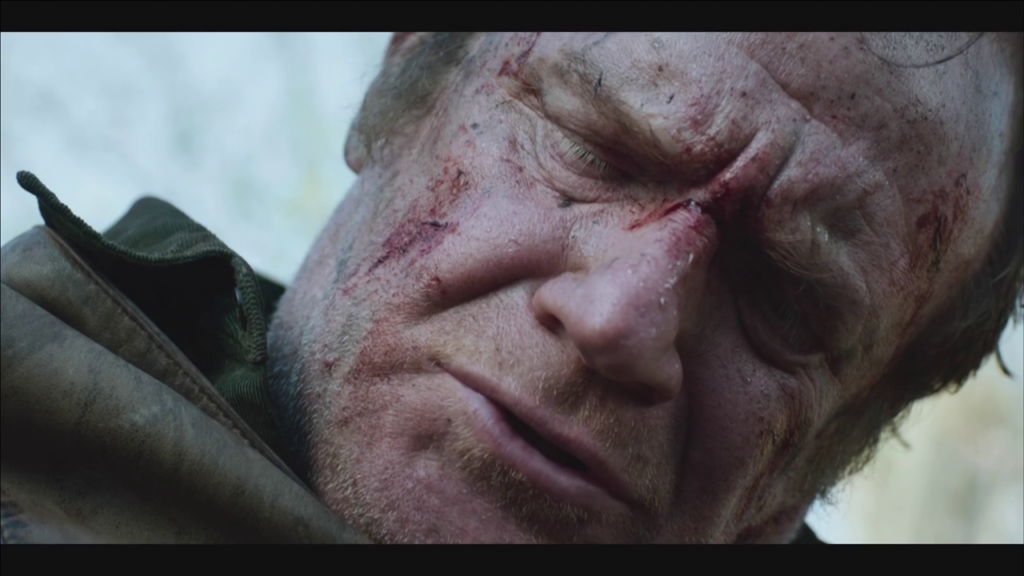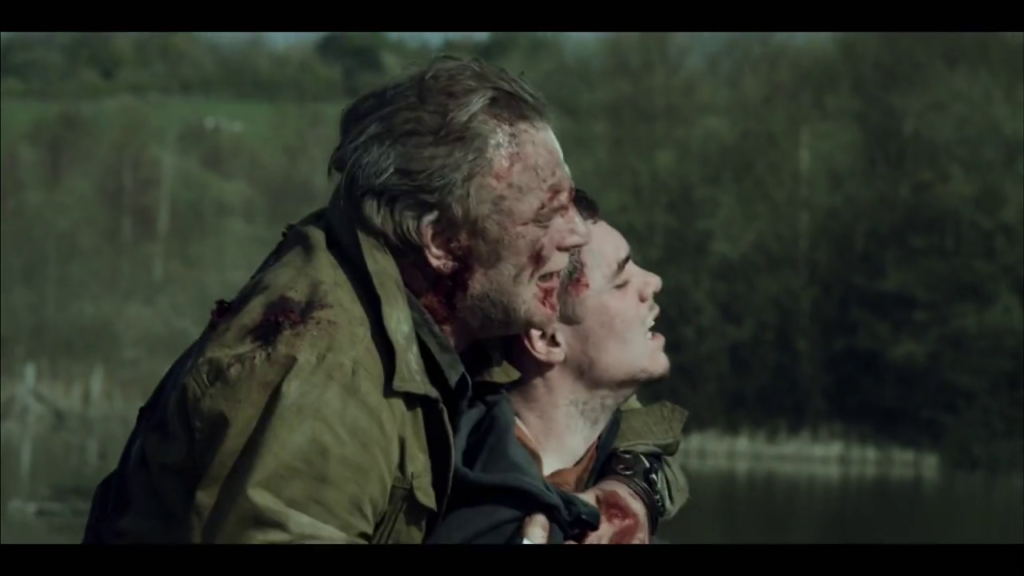Gangs of London
Season 1
Episode 5
The Danes bring the pain
Episode 4 of Gangs of London ended on a heck of a cliffhanger, with Elliot bleeding out on the Wallaces’ dining table, while an assassin embedded in the wait staff (Laura Sofia Bach) almost succeeds in gunning down Sean in his own home.
The forces arrayed against the Wallace organisation have stuck their heads above the parapet for the first time, and after the chaos of that episode’s climax, it seemed like the show was finally primed to start providing answers and paying off its mysteries.
Those will have to wait a little longer, though, because Episode 5 does something unexpected. Rather than forging ahead with the show’s central drama just when it had been brought to a boil, it spends a full hour tying up a tertiary plotline. Chronologically, it winds back the clock to just after Episode 2. Sean doesn’t appear in the episode at all, notwithstanding the “previously on” segment at the start; neither does Elliot, Ed, Marian, Billy, Alex, Shannon, Luan, Lale… almost none of the primary cast at all. None of the scenes are even set in London.
Instead, we pick back up with the story of Kinney Edwards, the leader of the Traveller community massacred at the end of Episode 2, and his son Darren, the catspaw hired to kill Finn. Since being retrieved from the doss-house by his father in Episode 1, Darren has been hiding out in a remote, two-storey farmhouse on the wind-bitten northwestern coast of Wales. There, he spends his days waiting for a boat to arrive that will take him overseas, far away from anyone who knows about the calamitous chain-reaction he unwittingly set in motion. The only people he has for company are Mal (Richard Harrington), his father’s terse second-in-command who barks orders at him to stay away from the windows, and Evie (Caroline Lee-Johnson), the kindly, perceptive owner of the house, who runs an ammunition manufacturing operation from its concealed basement, and who apparently makes a habit of taking in teenage vagrants.

We cut back and forth between Darren and Kinney, who, after surviving the Wallaces’ assault on his campsite, managed to crawl into the woods and patch shut the wound in his side with dirt and dead leaves. It’s from here that he sees a group of mercenaries, outfitted in chic, black tactical gear and wielding high-spec automatic weapons, combing through the ruins of the caravans. They speak to each other in Danish.
At their head is Leif (Mads Koudal – briefly seen in the previous episode holding Floriana prisoner), and by his side is Tove (Laura Sofia Bach – the same assassin we saw in the Wallace house). They find a burner phone in the wreckage, still displaying the text conversation between Kinney and his contact, requesting the boat to carry Darren to safety. With that, the clock starts and the chase is on.
This is the second of the two episodes in Gangs of London’s first season to be directed by Gareth Evans. One gets the distinct impression that, when he and co-creator Matt Flannery were outlining the show, they carved out this one episode as a kind of treat for themselves; an action-thriller short film that’s largely excerptable from the rest of the series’ plot. Certainly, it feels like an indulgence on the part of two guys from rural Wales to set an hour of a show called Gangs of London in… rural Wales.
One gets the distinct impression that, when [Evans] and co-creator Matt Flannery were outlining the show, they carved out this one episode as a kind of treat for themselves.
The first strength that people tend to note about Evans as a director is his facility with high-key action and violence. That’s correct, but the other side of that coin is that he’s fabulously gifted with sequences of tension; of letting scenes linger, of letting the audience squirm at the potential for violence to erupt at any moment.

The first half-hour of Episode 5 is a deliberately, gruellingly slow burn, a notch-by-notch tightening of the noose. We follow Kinney on a Homeric quest across the Welsh countryside; severely injured and without allies, but determined to come to his son’s rescue before the Danes get to him first. Set-pieces like the one where he steals an innocent farmer’s jeep and shotgun, or the one where he hides in a bathroom stall from an inquisitive merc, benefit from drum-tight spatial geography and sound editing (the scrape of the gun barrels on both sides of the bathroom stall door, while their owners suppress their breathing, is exquisite). Mark Lewis Jones plays Kinney as an antihero exceptionally well – he brings the same rawness and edge to the part that he did to Quinn in Apostle. He’s a thoroughly unglamorous character, with his potato-faced profile, gravelly voice, and ruthless, painful pragmatism (at one point, we’re treated to a revolting close-up where he pulls a living worm out of the wound in his side.) His corporeal decay and grubby single-mindedness stand in contrast to the cool, coiffured, robotic Danes.
[Kinney’s] corporeal decay and grubby single-mindedness stand in contrast to the cool, coiffured, robotic Danes.
The scenes spent in the farmhouse with Darren and his companions act as a sort of ironic counterpoint to Kinney’s odyssey; being unaware of the doom bearing down on him hour by hour, the young, naive hitman begins to hope that there might be life after Ioan; after Finn Wallace. It’s a hope that’s cruelly snatched away when he dares to peek out the window, and glimpses his father stumbling across an open field, screaming an awful warning.
The episode’s two plotlines converge with a bravura, God’s-eye tracking shot, drawing a straight line from the Danes, advancing across the moor in broad daylight, over Kinney stumbling just ahead of them, to the farmhouse, isolated and exposed in the middle of nowhere.
As for what happens next…
Reader, I have a confession to make: I’m generally a movie guy, not a TV guy. I don’t have the kind of comprehensive familiarity with the medium of television to authoritatively make superlative judgements, like “best,” or “greatest.” Instead, I’ll limit myself to saying this:
If there has ever been an episode of TV with a gunfight more spectacular than the one in Episode 5 of Gangs of London, I’ve never seen it. And I’d be gobsmacked if I learned it exists.

If there has ever been an episode of TV with a gunfight more spectacular than the one in Episode 5 of Gangs of London, I’ve never seen it.
It becomes clear, very quickly, that the explosive finale of Episode 2 was just an amuse-bouche for the action choreography that dominates the last twenty minutes of Episode 5. Calling the sequence “heightened” doesn’t do it justice; Evans stages the Danes’ assault on the farmhouse with the sort of epic, blood-and-thunder intensity one might associate with the Battle of Helm’s Deep, or the final reels of Fritz Lang’s Die Nibelungen. It’s a bleak, brutal opera of roaring automatic weapons and erupting squibs.
The farmhouse isn’t just a farmhouse, you see. Evie has fortified her base of operations, and after the initial fusillade that cuts down her teenage charges in their droves, they manage to drop the reinforced shutters and mount a counterattack. (If I have one significant criticism of this episode, it would be that we don’t get to spend time with the other youths in Evie’s care prior to the big battle. Most of them are introduced in the same scene where they’re gunned down, and feel like a perfunctory inclusion to pad the bodycount. This is the single biggest factor preventing me from calling Episode 5 a Tour de Good.) The Danes, undeterred, break out the siege ladders and begin probing for entrances through the upper floors. One tries to drop into the living room through the chimney, and ends up getting set on fire for his trouble.
This is Evans and Flannery on their absolute top form; a high point in their shared career. The handheld camera roves intently through the farmhouse, capturing every gory beat of the action in clear, full-frame detail. It’s an inimitable style that the director and cinematographer have perfected over the years. It isn’t spontaneous; each whip-pan and push-in has conspicuously been worked out in advance, obviously primed to capture the movement of human bodies for maximum impact. But it feels immediate, and localised, our point-of-view in the thick of things with the characters. The camera is a dance partner with the human performers, working with them to make their struggles and their deaths as loud and proud as possible.
Mal, Evie, and Kinney give the Danes a hell of a fight; they make the attackers pay twice over for every one of their number they kill. There’s a hyper-slow-motion shot where Mal, after being riddled with bullets, drops a duffel bag of explosives on the remaining attackers. (Watching this episode with my Dad back in 2020, he turned to me when he saw the attendant gore effect and exclaimed: “Oh my God! I don’t think I’ve ever seen someone get blown to bits like that!”)

But it’s all, ultimately, futile. With Evie dead, and Mal dead, Kinney tries to make his escape down the concealed trapdoor and to the harbour with Darren. It’s a valiant effort, but Leif dispassionately guns them both down from his vantage on the clifftop, together with Albert (Ioan Hefin), Evie’s husband and the skipper of the boat meant to bear Darren to safety. At the end of the episode, Leif takes a call from his employer; it’s none other than Jevan, the same silver-spoon dandy that Alex and Ed met with in Episode 4. “I’ve got another target,” he intones. “Another son.”
When I first saw Episode 5, I confess, its ending sat uncomfortably with me. It felt an awful lot like a Shaggy Dog Story, Kinney’s Herculean effort to protect his son ultimately amounting to nothing. With the benefit of hindsight, though, I think this episode works spectacularly as a sort of centrepiece to Gangs of London’s first season. It’s completely tangential to the main plot, but in a weird, counterintuitive way, that actually makes it more effective thematically.
A serialised, soap-operatic TV show like Gangs of London lives and dies by the tangled network of interrelationships between its characters. A character is existentially confirmed by the way their actions reverberate and resonate throughout the rest of the cast, impacting people with whom they’ve had no direct connection. In Episode 1, Elliot chases down Besmir; as an indirect result, Ed slits Jack’s wrists. In Episode 2, Lale schemes to steal Asif’s heroin, and by the domino chain of causality, Sean and Billy end up having a heartfelt moment together. Hell: the whole premise of the series is that the decisions Finn Wallace made in life continue to echo after his death.
But Darren and Kinney are denied any such resonance. With the benefit of having watched further ahead, I can confirm that Episode 5 represents the end of their narrative utility. There are no seeds being planted in this episode; no sly plot devices that will pay off later. Darren and Kinney aren’t just dead; they’re functionally erased from memory, a loose end successfully tied off, consigned to a deeper ignominy than death. The show, henceforth, will proceed as though they never existed at all.
Darren and Kinney aren’t just dead; they’re functionally erased from memory, a loose end successfully tied off, consigned to a deeper ignominy than death.

Gangs of London is a story that’s deeply concerned with the relationships between fathers and sons; with that irrational, inextricable bond between generations. A bold move that Episode 5 makes – and the episode is comprised of almost nothing but bold moves – is that it doesn’t sentimentalise the relationship between Kinney and Darren. There are no illusions here: Kinney is not a good Dad. Darren’s impetus to accept the hit on Finn’s life in the first place was to get enough money to run away from home with Ioan (the opening flashback strongly suggests that he and Ioan were lovers). When Kinney is dragging Darren out through the trapdoor, he hands his son a revolver. Darren’s first impulse is to point it at Kinney; but even given a clear shot, he can’t bring himself to shoot his Dad in reprisal for Ioan’s murder. Kinney offers him a promise in response:
“You let me get you on that boat, and I’ll let you pull the fucking trigger.”
Is that love? A perverse, ugly, guttural sort of love, maybe. It’s certainly dedication, born of an animalistic, paternalistic sense of obligation to one’s offspring. Can that strength of dedication really be wiped out; stricken from the record; made to count for nothing?
Well… yes. Episode 5 suggests that, yes, it can, with enough financing and resources and brute firepower. The bonds between fathers and sons can, in fact, be crushed by the indifferent gears of global commerce; ground down into the undifferentiated mulch of history. Those are the horrifying powers now bearing down on the Wallaces, and their memory of Finn.
Frankly: I would throw out every other episode of Gangs of London if it meant this one was preserved. The show as a whole is entertaining. Sometimes it’s even really good entertainment. But Episode 5, alone, feels to me like art.
- Review Series: Gareth Evans
- Review Series: Gangs of London
Is It Good?
Exceptionally Good (7/8)
More Gangs of London reviews
Andrew is a 2012 graduate of the University of Dundee, with an MA in English and Politics. He spent a lot of time at Uni watching decadently nerdy movies with his pals, and decided that would be his identity moving forward. He awards an extra point on The Goods ranking scale to any film featuring robots or martial arts. He also dabbles in writing fiction, which is assuredly lousy with robots and martial arts.


3 replies on “Gangs of London, Season 1, Episode 5”
I really enjoyed this guys review of the episode. You’re a talented writer mate!
That’s good of you to say, Sam, cheers! I try to bring my best effort to these.
Fantastic review-we agree wholeheartedly with all your thoughts on the quality of the film making in this episode. It’s just outstanding work!! Thank you!